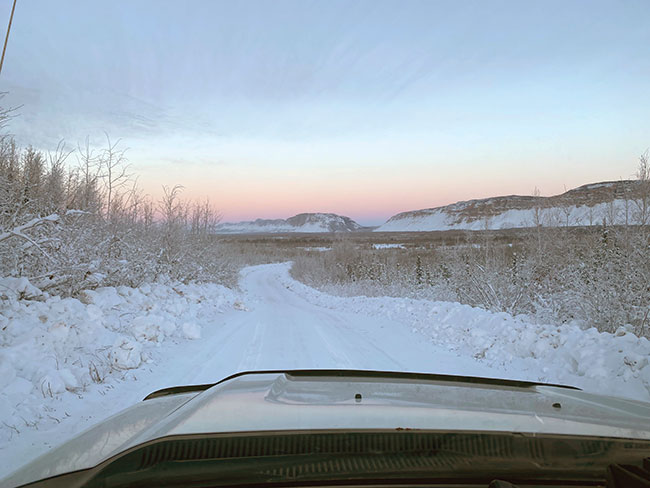
Features
Roads & Paving
Critical link: inside winter road construction
Winter roads are a vital connection for remote, northern communities
March 21, 2024 By Mike Lacey
 A view of Gibson’s Gap on the Mackenzie Valley Winter Road (MVWR) in the Northwest Territories. Photo: Michael Hempler, Highway Maintenance Supervisor, NWT
A view of Gibson’s Gap on the Mackenzie Valley Winter Road (MVWR) in the Northwest Territories. Photo: Michael Hempler, Highway Maintenance Supervisor, NWT Each year, thousands of kilometres of ice and winter roads are built across Canada. These roads are a vital lifeline to remote communities in the country’s isolated, northern lands.
Here’s what you need to know about those roads.
How are ice and winter roads built?
Unlike a typical all-weather road that is constructed of aggregates, winter roads are constructed out of snow, ice and water. Dustin Dewar, regional highway manager with the Northwest Territories, says snow cats, graders, water trucks and loaders are used to construct and maintain the territory’s 900-kilometre winter road system.
Anita Tamrazi, with the Ontario Ministry of Northern Development, notes that in northern Ontario, some water crossings have pre-engineered bridges or culverts installed. This year, the Ontario government is spending $5 million for the installation of pre-engineered bridges or culverts and repairs to existing structures. As well, Tamrazi adds, other ‘ice bridges’ consist of logs and brush laid into a creek or stream with snow packed on top.
Tamrazi states that for 2023-24, the Ontario government will spend $6 million to fund construction and maintenance of the winter roads network to 32 remote Indigenous communities and the Town of Moosonee.
In northern Ontario, communities are responsible for building the roads and own or lease the equipment. While some communities have licensed mechanics on-site to repair and maintain equipment, Tamrazi says other communities may fly in skilled tradespeople to repair damaged equipment.
In the Northwest Territories, the work is handled by eight different road contractors and about 60 people are involved in the construction each year.
Why are these roads so important?
According to the Ministry of Northern Ontario, its 3,200 kilometres of winter roads connect remote and First Nation communities in the far north to a permanent highway or railway system. This allows essential goods and services to more easily reach these communities. As a result of the winter road system, medical and construction supplies, food and fuel are shipped in at a lower cost. Winter roads also improve access to primary health care services. Many of these communities are only connected to the all-weather road system through winter and ice roads. As such, when winter roads are not in use, travellers in and out must do so through plane or, in some cases, train.
Sandy Lake, a remote, fly-in First Nations community in northern Ontario, is an example of this. That community notes the winter road season lasts anywhere from six to 11 weeks and is vital for its residents.
“It is during this time that the community ships essential materials and equipment for the year that would not otherwise be economical or possible to ship by plane,” the community states on its website.
How long are winter roads in use?
While weather dependent, typically these roads are open from mid-January until the spring thaw. According to Dewar, the roads in the Northwest Territories are closed by March to allow for spring freshet.
Tamrazi states that in north Ontario, the roads can open to vehicles within six to seven weeks of construction, but it is weather dependent.
Once spring hits, the roads disappear.
“The roads completely melt, leaving only the cleared rights-of-way visible through the forested section,” states Tamrazi, noting these rights-of-ways are inaccessible outside the winter season.
Print this page